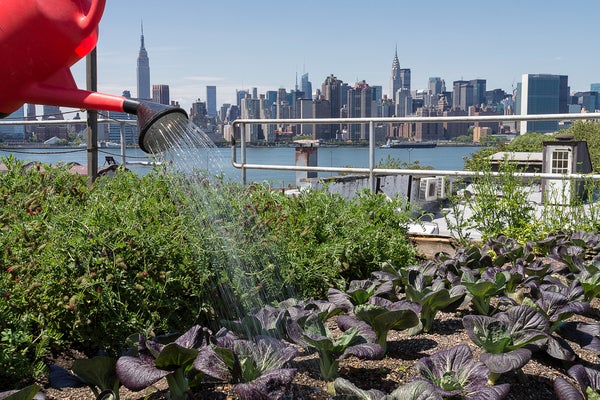Stroll through any trendy neighborhood of Brooklyn, N.Y., and you’ll notice little pockets of green tucked between the concrete and brownstones. Many of these miniature oases are community gardens, spaces dedicated to growing produce ranging from kale to squash to tomatoes right in the heart of the city. Such projects are often seen as a climate solution—a way to enjoy fresh, local food with minimal environmental impact. But though these spaces have many upsides, reducing carbon emissions isn’t always one of them.
A new study in Nature Citiescompared carbon emissions from small farms and gardens in major cities across the U.S. and Europe with those of a typical industrial farm. The results may surprise many climate-conscious and well-meaning urbanites: per serving of produce, the carbon cost of low-tech urban farms can be up to six times greater than that of industrial farming operations. “We knew it would be high, but we didn’t realize it would be so high,” says study co-author Joshua Newell, a sustainable development researcher at the University of Michigan.
But the process of growing food in cities doesn’t have to be so carbon-intensive, however, Newell says. In fact, when done right, it could have huge environmental and societal benefits—and many researchers still see it as an important part of a more sustainable future.
On supporting science journalism
If you're enjoying this article, consider supporting our award-winning journalism by subscribing. By purchasing a subscription you are helping to ensure the future of impactful stories about the discoveries and ideas shaping our world today.
Urban agriculture—whether it describes towering, high-tech vertical gardens or a small patch of dirt with a few basil plants—has become increasingly popular around the world as food movements such as eating local produce and growing organic crops have gained momentum. These operations are often viewed as a sustainable, community-focused alternative to big industrial farms. But until recently, few studies actually looked at their environmental impact.
Newell and his team decided it was time to change that. Using data from 73 low-tech city farms, community gardens and personal plots of land, they measured the average carbon emissions from growing a single serving of urban produce (say, one medium potato) against the carbon released by growing the equivalent on a conventional commercial farm. The team found that because of urban gardens’ relatively low yields, along with the energy used in constructing the planting beds, big-city spuds were significantly more carbon-intensive than commercially grown ones. This held true even when the researchers factored in emissions from transporting commercially grown produce to often distant grocery stores. “Just because it’s local doesn’t mean it has a lower carbon footprint,” Newell says.
One person who wasn’t surprised by these results was Carolyn Dimitri, a New York University applied economist, who studies food systems but wasn’t involved with the new work. Small, scattered urban plots can’t compete with industrial farms in terms of output, she says. Proportionally, it takes a lot more fertilizer, water and new infrastructure to grow a serving of vegetables in a relatively tiny urban space, compared with a conventional farm, which is already designed for high yields. That massive difference in scale and optimization accounts for most of the carbon discrepancies.
That doesn’t mean that growing vegetables in big cities is inherently bad, however. “Urban farming is great,” if imperfect, says Carola Grebitus, a sociologist specializing in food choice at Arizona State University. It can be a powerful tool for education and job creation, she says, and a good way to introduce fresh produce to urban “food deserts” where healthy fruits and vegetables are hard to come by. Community gardens can also provide a psychologically beneficial place to connect with nature, and the added green space can help mitigate dangerous heat and flooding.
Conscious of these benefits, Newell’s team highlighted a number of ways to make urban agriculture more sustainable from a climate perspective. One option is to be selective about what crops are grown. Tomatoes grown in the city, for instance, have a carbon footprint equal to or lower than their industrially farmed counterparts. That’s because most commercially produced tomatoes start life in the greenhouse—a resource- and energy-intensive farming method. And a few other highly perishable crops that need to be refrigerated right away, such as asparagus and herbs, have about the same carbon footprint whether they’re grown in urban or industrial farm settings.
Another strategy is to rely on existing infrastructure as much as possible. Nearly two thirds of the carbon emissions from urban agriculture came from operations related to infrastructure, including the demolition and remodeling of old buildings rather than the incorporation of these structures into a new garden’s design. The equipment needed to demolish an old building, not to mention a building’s original construction, can emit a lot of carbon. Finally, Newell says, any urban farm should take the local climate, water quality and soil into account. Growing plants that are ill-suited to an area requires more water, energy and pesticides, all of which take an environmental toll. Oranges won’t thrive in New York City, for example, but they can bear lots of fruit under the hot Phoenix sun.
For Dimitri, this study represents an important step in opening up a more nuanced discussion about urban agriculture. She hopes that future research will highlight even more of the distinctions between commercial farms and urban gardens in different locations. “A farm in Germany is not the same as a farm in the U.S.,” she says. “So it would be nice to see maybe country-by-country discussions.”
Rather than a one-size-fits-all climate solution, perhaps it is best to view urban farming as something as unique as the vibrant metropolises it is practiced in—each plot as different from others as Munich is from Detroit or New York City is from Paris.
